B-hPD-1 plus/hPD-L1 mice
| Strain Name | C57BL/6N-Pdcd1tm3(PDCD1)BcgenCd274tm1(CD274)Bcgen/Bcgen | Common Name | B-hPD-1 plus/hPD-L1 mice |
| Background | C57BL/6 | Catalog number | 112550 |
|
Related Genes |
CD279, PD-1, PD1, SLEB2, hPD-1, hPD-l, hSLE1; B7-H, B7H1, PD-L1, PDCD1L1, PDCD1LG1, PDL1, hPD-L1 |
||
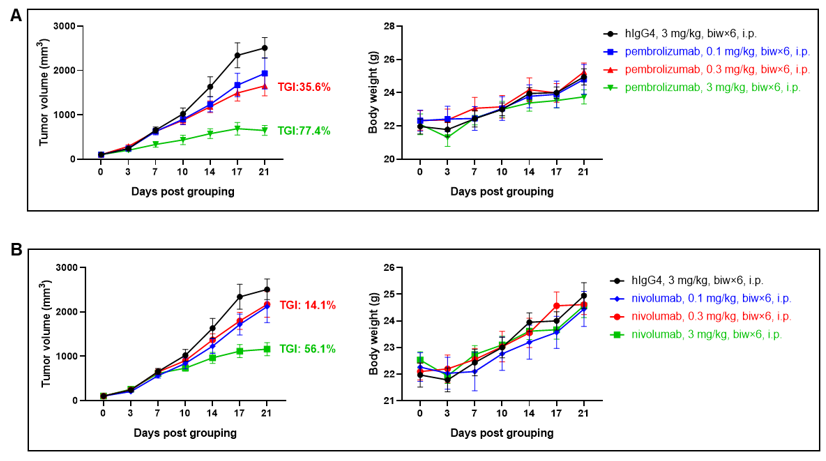
Antitumor activity of anti-human PD-1 antibodies in B-hPD-1 plus/PD-L1 mice. Anti-human PD-1 antibody pembrolizumab (in house) and nivolumab (in house) inhibited the growth of B-hPD-L1 MC38 plus in B-hPD-1 plus/PD-L1 mice. Murine colon cancer B-hPD-L1 MC38 plus cells were subcutaneously implanted into B-hPD-1 plus/PD-L1 mice (female, 8-week-old, n=6). Mice were grouped when tumor volume reached approximately 80-120 mm3, at which time they were treated with anti-human PD-1 antibodies with doses indicated in panel. (A) Tumor volume and body weight of mice treated with pembrolizumab. (B) Tumor volume and body weight of mice treated with nivolumab. Results showed that pembrolizumab and nivolumab were both efficacious in controlling tumor growth in B-hPD-1 plus/PD-L1 mice. The tumor inhibitory effects were dose-dependent. The results demonstrate that the B-hPD-1 plus/PD-L1 mice provide a powerful preclinical model for in vivo evaluation of anti-human PD-1 antibodies. Values are expressed as mean ± SEM.

Flow cytometry analysis of tumor infiltrating lymphocytes (TILs). Tumor cells were harvested at the endpoint of experiment (n=3). Flow cytometry analysis of the lymphocytes were performed to assess cell proportion changes in anti-human PD-1 antibodies (in house) treated groups compared to the group treated with isotype antibody. Values are expressed as mean ± SEM.
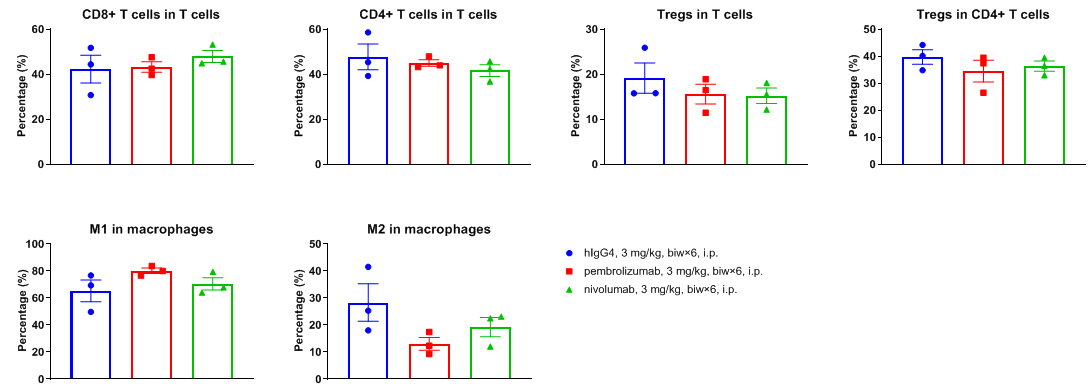
Flow cytometry analysis of tumor infiltrating lymphocytes (TILs). Tumor cells were harvested at the endpoint of experiment (n=3). Flow cytometry analysis of the lymphocytes were performed to assess cell proportion changes in anti-human PD-1 antibodies (in house) treated groups compared to the group treated with isotype antibody. Values are expressed as mean ± SEM.

Flow cytometry analysis of tumor infiltrating lymphocytes (TILs). Tumor cells were harvested at the endpoint of experiment (n=3). Flow cytometry analysis of the lymphocytes were performed to assess cell proportion changes in anti-human PD-1 antibodies (in house) treated groups compared to the group treated with isotype antibody. Values are expressed as mean ± SEM.
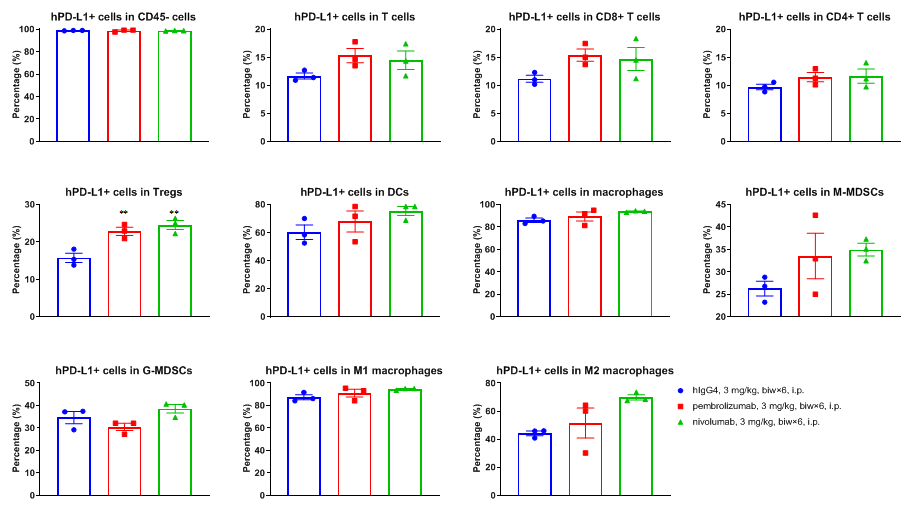
Flow cytometry analysis of tumor infiltrating lymphocytes (TILs). Tumor cells were harvested at the endpoint of experiment (n=3). Flow cytometry analysis of the lymphocytes were performed to assess cell proportion changes in anti-human PD-1 antibodies (in house) treated groups compared to the group treated with isotype antibody. Values are expressed as mean ± SEM.
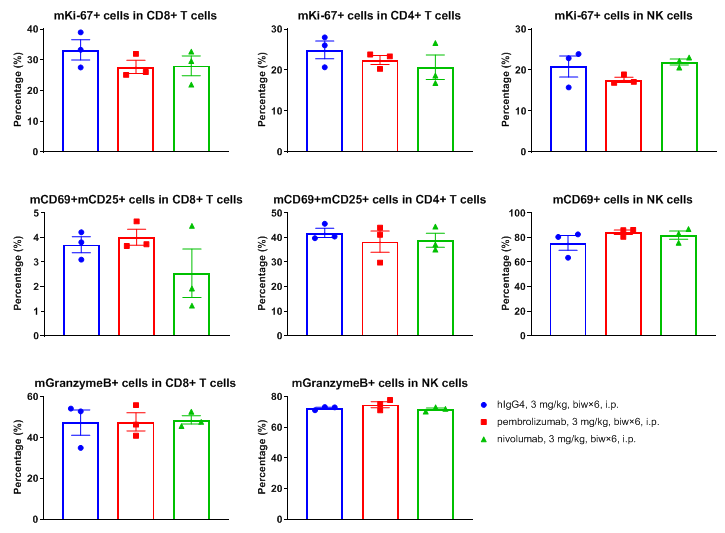
Flow cytometry analysis of tumor infiltrating lymphocytes (TILs). Tumor cells were harvested at the endpoint of experiment (n=3). Flow cytometry analysis of the lymphocytes were performed to assess cell proportion changes in anti-human PD-1 antibodies (in house) treated groups compared to the group treated with isotype antibody. Values are expressed as mean ± SEM.

Flow cytometry analysis of tumor infiltrating lymphocytes (TILs). Tumor cells were harvested at the endpoint of experiment (n=3). Flow cytometry analysis of the lymphocytes were performed to assess cell proportion changes in anti-human PD-1 antibodies (in house) treated groups compared to the group treated with isotype antibody. Values are expressed as mean ± SEM.
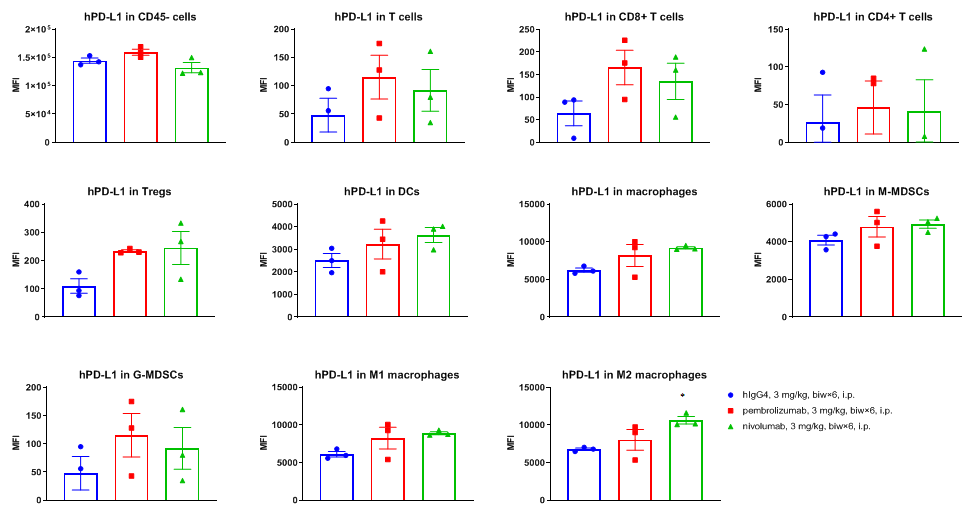
Flow cytometry analysis of tumor infiltrating lymphocytes (TILs). Tumor cells were harvested at the endpoint of experiment (n=3). Flow cytometry analysis of the lymphocytes were performed to assess cell proportion changes in anti-human PD-1 antibodies (in house) treated groups compared to the group treated with isotype antibody. Values are expressed as mean ± SEM.












 京公网安备:
京公网安备: